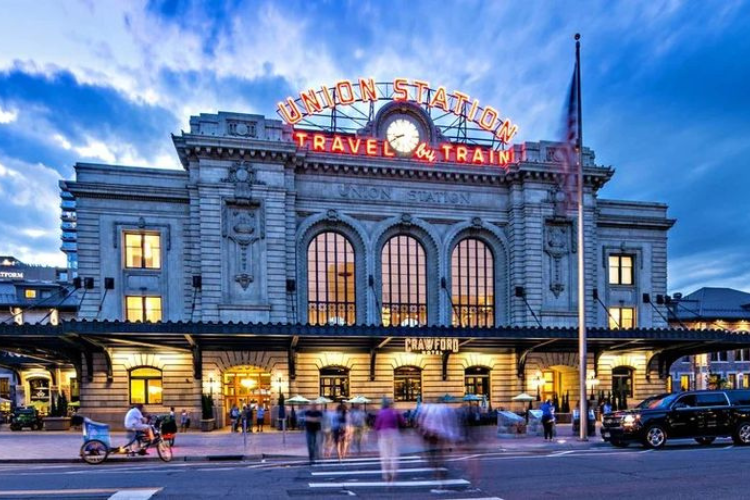Union Station Denver with Bla Bla City Tours
Union Station, situated in Lower Downtown Denver (LoDo) on Wynkoop Street between Eighteenth and Sixteenth Streets, serves as the city’s main transportation center. Originally opened in 1881 as Denver’s first consolidated railroad depot, the station underwent a significant renovation in 2014, transforming it into a modern transportation hub and vibrant visitor attraction.

1. The Birth of Union Station: A Centralized Railroad Depot
Union Station, located in Lower Downtown Denver (LoDo), opened in 1881 as the city’s first consolidated railroad depot. Before its establishment, Denver’s rail traffic was spread across multiple stations. The Denver Pacific Railroad, Kansas-Pacific Railroad, and Colorado Central Railroad were among the early railroads using different stations, making transfers cumbersome. The creation of Union Station marked a significant development, unifying Denver’s rail services under one roof and streamlining transportation in the city.

2. Early Development and Construction of Union Station
The momentum for a centralized station began in 1879, driven by Jay Gould, who controlled most of Colorado’s railroads. The Union Depot and Railroad Company (UDR) was formed to create this unified terminal. Construction began in 1880, and by May 1881, the depot was operational. The original structure, designed in an Italian Romanesque style, featured stone from Colorado quarries and a 128-foot tall tower.
3. Architectural Highlights of the Original Union Station
The original Union Station was an architectural marvel, constructed with stones from near Castle Rock and sandstone trim from Morrison. The building measured 65 feet by 503 feet and included a 128-foot tall clock tower. It housed baggage and office facilities in its wings, while passenger services were centralized. The design and scale of the station made it one of the largest depots in the American West at the time.
4. The 1894 Fire and Reconstruction Efforts
In 1894, a fire caused by an electrical fault destroyed the central part of Union Station. Despite the extensive damage, the waiting room and baggage area reopened the next day. Reconstruction efforts led to a new 168-foot tall tower, featuring four clocks each 14 feet in diameter. This reconstruction reinforced the station’s role as a critical transportation hub in Denver.
5. Twentieth Century Renovations and Additions
The early 20th century saw significant renovations to Union Station. In 1914, the central part of the structure was remodeled to feature a Neoclassical front, replacing the original clock tower. The tracks were elevated five feet in 1916, improving passenger access with tunnels. Mechanical interlocking devices and umbrella sheds were also installed to enhance the station’s functionality during inclement weather.
6. The 1906 Welcome Arch: A Short-Lived Landmark
In 1906, Denver citizens dedicated a large arch in front of Union Station, featuring 17 tons of metal and 1,600 light bulbs. Originally reading “Welcome” on both sides, it was changed to “Mizpah” on one side in 1908. By 1930, structural concerns led to its dismantling. Despite its brief existence, the arch remains a notable part of Union Station’s history.
7. Decline in Rail Traffic and Preservation Efforts
With the rise of air and car travel in the mid-20th century, rail traffic at Union Station declined. By the 1950s, usage had dropped significantly, and by 1974, only five trains used the station daily. Efforts to preserve the historic structure included its addition to the National Register of Historic Places in 1974. These efforts highlighted the cultural and architectural significance of Union Station.
8. Modern Transformation: The 2014 Redevelopment
In 2002, plans for a major redevelopment of Union Station began. The project was a collaboration between the Regional Transportation District (RTD), the City and County of Denver, the Colorado Department of Transportation, and the Denver Regional Council of Governments. Completed in 2014, the redevelopment transformed Union Station into a modern transportation hub, integrating Amtrak and RTD services with new amenities.
9. Union Station Today: A Vibrant Urban Hub
Today, Union Station is more than a transportation center. It is a vibrant urban hub featuring the Crawford Hotel, numerous restaurants, and shops. The revitalization of the station has made it a popular destination for both locals and visitors. Its modern facilities and historic charm offer a unique blend of past and present, making it a focal point in downtown Denver.
10. Exploring Union Station: Dining, Shopping, and Accommodations
Visitors to Union Station can enjoy a variety of dining options, from casual eateries to fine dining restaurants. Unique shops offer a range of goods, from local crafts to high-end fashion. The Crawford Hotel provides luxurious accommodations within the station, combining historic elegance with modern comforts. Union Station continues to be a cornerstone of Denver’s urban landscape, offering a rich blend of history, culture, and convenience.
Latest Posts from Bla Bla City Tours
Stay updated with the newest adventures, tips, and stories from Bla Bla City Tours. Discover the best of Denver, Colorado, and beyond through our latest blog posts.



